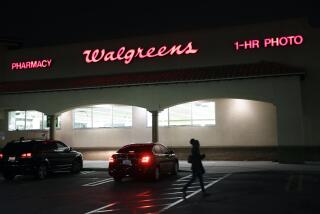Clock Is Ticking on Lackluster Mervyn’s
The parent of Mervyn’s on Tuesday threatened to get rid of the 268-store department chain unless sales pick up significantly in the next 12 to 18 months.
The announcement by Dayton Hudson underscored the depths of the problems at Mervyn’s, which has lost price-conscious customers to fast-growing discount chains. Analysts said Mervyn’s has been particularly hurt by Target--also owned by Dayton Hudson--which offers clothing and accessories at prices lower than found at Mervyn’s.
Mervyn’s is based in Hayward and has about half of its stores in California. It accounts for about 15% of Dayton Hudson’s revenue.
Dayton Hudson Chairman Robert Ulrich, while threatening to dispose of Mervyn’s, said he expected the chain’s performance to improve. Mervyn’s recently added such national brands as Nike and Villager to improve its image and attract shoppers.
At the same time, though, Ulrich said he would not continue to tolerate weak sales at Mervyn’s. “If we do not achieve reasonable and consistent . . . sales growth at Mervyn’s over the next 12 to 18 months, we will carefully pursue alternative ways to generate increased shareholder value from Mervyn’s,” Ulrich said in a prepared statement.
Dayton Hudson, based in Minneapolis, declined to say whether it would sell or spin off the mid-price department store chain. And it held out the possibility that it might continue to operate Mervyn’s if a buyer cannot be found and if a spin off is not possible.
Analysts and investors have been lobbying Dayton Hudson to dump Mervyn’s so the company can focus on expanding its highly profitable Target discount stores.
Sales at Mervyn’s have been lackluster, in contrast to gains at Target. Same-store sales at Mervyn’s have been flat this year, while same-store sales at Target have risen 5.9%. Same-store sales are considered the best sales indicator because they exclude the effect of sales from new, remodeled or closed stores.
“The clock is now ticking on Mervyn’s,” said analyst Joseph Ronning of Brown Bros., Harriman & Co. “Mervyn’s has been a disappointment for years.”
Mervyn’s woes point to a larger trend in retailing, where middle-of-the-road department stores, such as Sears, Roebuck & Co. and J.C. Penney Co., are having difficulty attracting loyal customers. Shoppers have been heading to discounters where they can pick up bargains or to specialty stores, such as the Gap, where they can get better brands.
Mervyn’s comes under scrutiny at a crucial time, with the all-important holiday shopping season around the corner.
Retailers rack up about one-quarter of the annual sales during the weeks between Thanksgiving and Christmas.
Dayton Hudson’s announcement heightens the pressure on Mervyn’s CEO Bart Butzer, who joined the chain from Target 18 months ago with orders to turn it around. Butzer added national brands, took steps to improve customer service and brought in new design teams to freshen Mervyn’s store-brand apparel lines.
In addition, Dayton Hudson spent $100 million in 1998 to refurbish Mervyn’s stores after closing 31 stores in 1997. However, none of the efforts so far has paid off.
Analysts suggested the changes might have hurt consumers by confusing them about what to expect from Mervyn’s.
Since 1994, it has steadily reduced the amount of store-brand merchandise it stocks, replacing familiar private labels with second-tier national brands.
Mervyn’s “doesn’t have an identity, and it doesn’t have a core customer,” said industry analyst Margaret Gilliam of the New York-based Gilliam & Co.
“It’s trying to find a niche between the discount chains and the traditional department stores, but consumers want low prices or better brand names,” Gilliam added.
Dayton Hudson shares rose $1.38 to close at $38.75 on the NYSE on Tuesday.
*
Bloomberg News was used in compiling this report.
More to Read
Inside the business of entertainment
The Wide Shot brings you news, analysis and insights on everything from streaming wars to production — and what it all means for the future.
You may occasionally receive promotional content from the Los Angeles Times.









